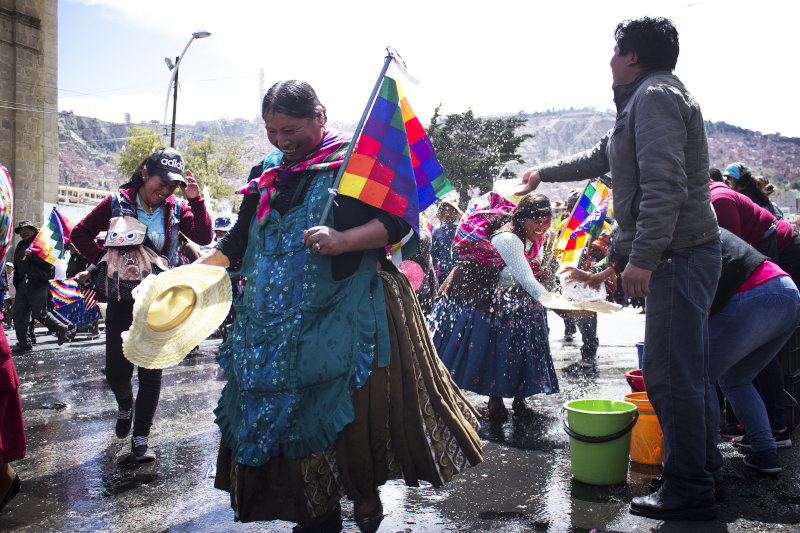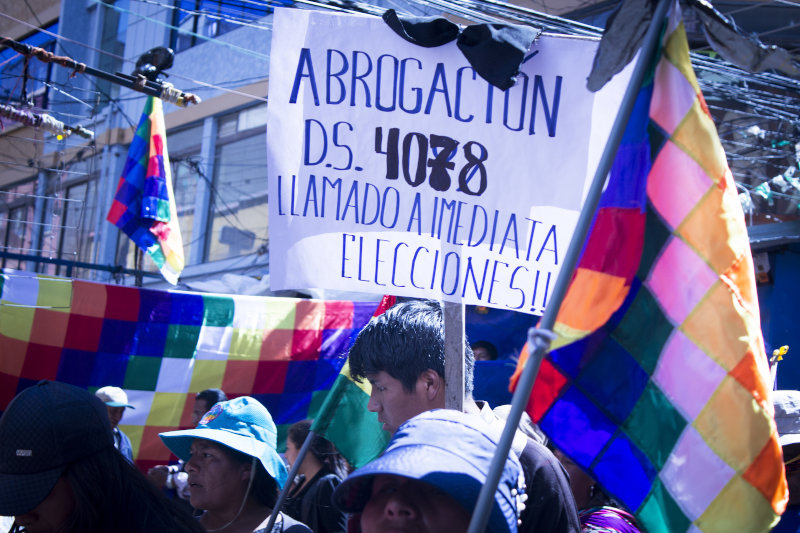The march left Senkata in the morning [of November 21] and proceeded all the way down El Alto’s 6 de Marzo avenue. As the marchers walked past, many vendors hid their wares, “they’re going to steal from us,” they said, but the march passed peacefully, marchers asking the people of La Paz to join their call for justice. Behind the coffins and the families in mourning from El Alto walked folks who had arrived from communities in Potosí
“We are not from the MAS, we are not terrorists, we are from El Alto and El Alto must be respected!” That was one of the chants that was repeated over and again, between demands for Añez’s resignation and that of Arturo Murillo, the current Interior Minister, who protesters blamed for the death of eight people by gunshot in Senkata.
As the massive funeral procession went through the Center (la Ceja) of El Alto towards La Paz, it was applauded by neighbours who gathered along the sidewalk. Together with the representation of District 4, we went down through La Portada and the Cemetery, where a small religious ceremony was held. I didn’t want to take pictures, because I was also there as someone who is grieving the eight people killed. As we walked toward the center of La Paz, many passersby offered water and soft drinks to the tired marchers, who hydrated themselves with what they received.

We took Montes street into downtown La Paz. The people were angry, for the dead, because of the indifference of the authorities. An older woman with braids and pollera (a long skirt) told us of the looting in her area, saying she didn’t want that, but she didn’t want more repression either. As soon as we arrived to San Francisco plaza in La Paz, many of the marchers stopped, others began to run, shouting: “They’re gassing the march down below!” “Stay calm, don’t run, keep straight, don’t turn around, don’t run!” “They don’t even respect the mourners!” yelled another woman.
The smell of tear gas made us cry, the people become even angrier as they dispersed.
Early in the morning, well before the march began to move through the streets, a driver said to me, jokingly, “They’re saying that thousands of people from El Alto are coming down [to La Paz] with their coffins out in front.” I ask myself what could be so funny about the arrival of a funeral march. But that’s the general feeling in La Paz: belligerence, and through the cracks we breathe air that’s heavy, laden with our divisions and our pain.
After the brutal police repression, various groups of people who participated in the march returned to the Cemetery. The groups of people from communities in the north of Potosí tried to go too, but local sellers and merchants tell them to leave, kicking them out because they are scared of them, because they think they could steal from stands and stores: a stigma that many unjustly carry because they are from El Alto, or from a community.

On November 10th and 11th, remember, groups–which, it is an open secret among residents, were in the service of the MAS–looted stores, houses and businesses in El Alto and La Paz, sowing a generalized panic. “But we’re not looters,” the mourners, carrying the coffins, insisted as they returned to El Alto via the Cemetery. They are mourning the dead, but the store owners yelled back that they don’t believe that’s true.
I have to ask myself what we’ve arrived to when we have to explain our skin color to others, explain our origins. The same thing happened when I was covering a protest outside of Plaza Murillo, before Morales resigned, which was demanding the cancellation of the elections. There, I was assumed to be from the MAS because of the way I was dressed and the color of my skin.
With tears in my eyes because of these scenes with coffins, these explanations and confrontations, which are constantly reproduced and are happening over and over again, I ask myself how we will repair these fractures, which are loaded with so much violence and indifference. Who wants to fix this? Yes, there’s people from the MAS in the mobilizations; no, they’re not the majority. Yes, the people of El Alto are tired, they’ve also gone out and taken down some blockades in their city, right now there’s another march for peace in El Alto.
In this series of events, this environment of violence, some justify the deaths. On social media, even folks who are close to me write that we should “celebrate that there were only eight dead” and not more, and that “irrational people from El Alto” were going to try and blow up the Senkata gas plant, destroying half of El Alto and maybe even part of La Paz. Lots of those who participated in today’s march stated the opposite: they are not people who don’t think, they would never allow that. I listen, I only manage to listen, crying for the dead and rejecting the political context that produced these deaths with all the strength that I can muster.
I keep asking myself where we’re going to get the strength to rebuild everything that, over 14 years, the now-collapsed regime rotted within social organizations, corroding them like acid. How do we reject the violence generated by groups of armed civilians (grupos de choque) and the formation of paramilitary groups, which is occurring from many sides. How do we face state repression, which will affect all of us: as we mourn our dead, others, way up above, are negotiating and making cold calculations on the blood that has been spilled.
Author Bio
Chaski Clandestina is a Bolivian independent media collective. This article was translated by Toward Freedom with permission from the author. Read the original, and access audio testimonies from marchers, videos and photographs here.
